Rice production in the Philippines faces several challenges. High import levels and low local yield are major issues, with the country producing only 19 million metric tons per year.
Climate change and soil degradation are harming agricultural stability, which results in inconsistent yields. Additionally, high production costs and a lack of investment in technology make it hard for local farmers to compete with those in neighboring countries.
To help farmers, the government has introduced programs like the Rice Competitiveness Enhancement Fund. This fund aims to improve food security by providing support to local rice farmers.
Furthermore, focusing on sustainable practices and regional collaboration can improve productivity and resilience in rice farming. By addressing these challenges, the future of rice farming in the Philippines can be more secure.
Overview of Rice Production
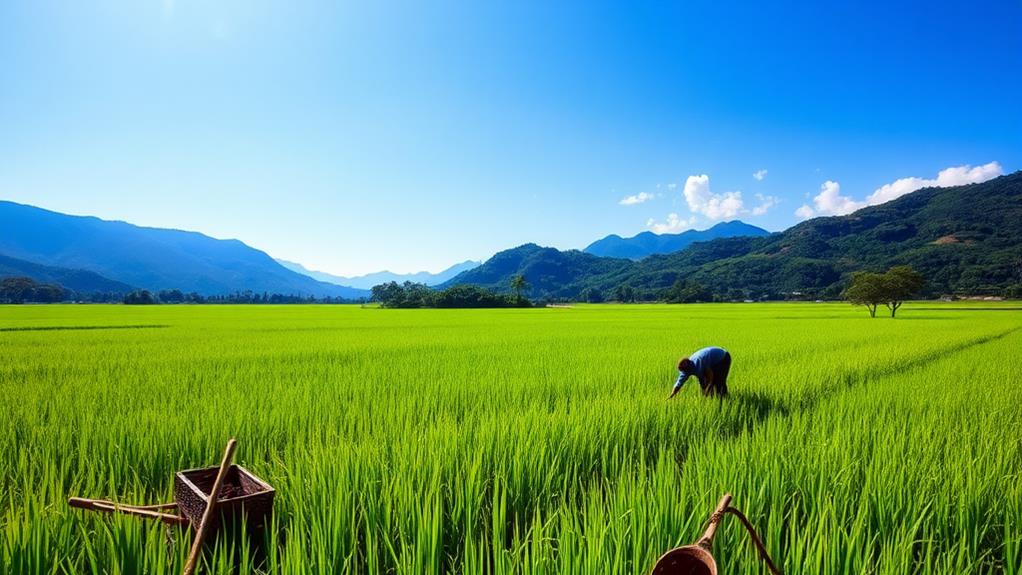
Rice production has significantly shaped the agricultural landscape in the Philippines. Rice accounts for 20% of the country's total agricultural output. The Philippines has 3.4 million hectares of land suitable for rice, but it still faces production shortfalls, making it the largest rice importer in the world. For example, in 2004, the country imported 2.2 million metric tons of rice, costing over US$ 500 million.
Despite being the 8th largest rice producer globally, with an average of 19 million metric tons annually, this amount is still not enough to meet local needs. The lack of productivity growth since the late 1980s has made these issues worse. High production costs and low investments in irrigation, fertilizers, and quality seeds prevent farmers from increasing output.
Market price fluctuations also complicate farming. For example, rice prices rose from P19.80/kg in 2008 to P27.60 in 2022, impacting both farmers and consumers.
To improve food security, it's essential to tackle these problems in rice production. Investments must focus on increasing productivity and stabilizing market prices. This will help create a more sustainable agricultural landscape in the future.
Key Environmental Challenges
Climate change is a major challenge for rice production in the Philippines. It causes low and inconsistent rice yields. Extreme weather events, such as heavy rain and long dry spells, disrupt the growth of rice plants. For example, more frequent droughts and floods make it harder for farmers to produce stable crops.
Soil degradation is another serious issue. Changing climate patterns reduce the fertility of the land, making it less productive.
Also, water scarcity is a critical concern. Without enough water, rice farming becomes unsustainable. Rising sea levels and flooding further decrease the amount of land available for growing rice.
Pest and disease outbreaks are increasing due to climate change. These outbreaks threaten rice crops and increase the risk of crop failure. This can lead to food shortages for millions of people.
Policymakers must act to address these challenges. They need to focus on sustainable farming practices and support research to find solutions.
If these issues are ignored, the agricultural sector and food security in the Philippines could face serious problems.
Economic Factors Affecting Production
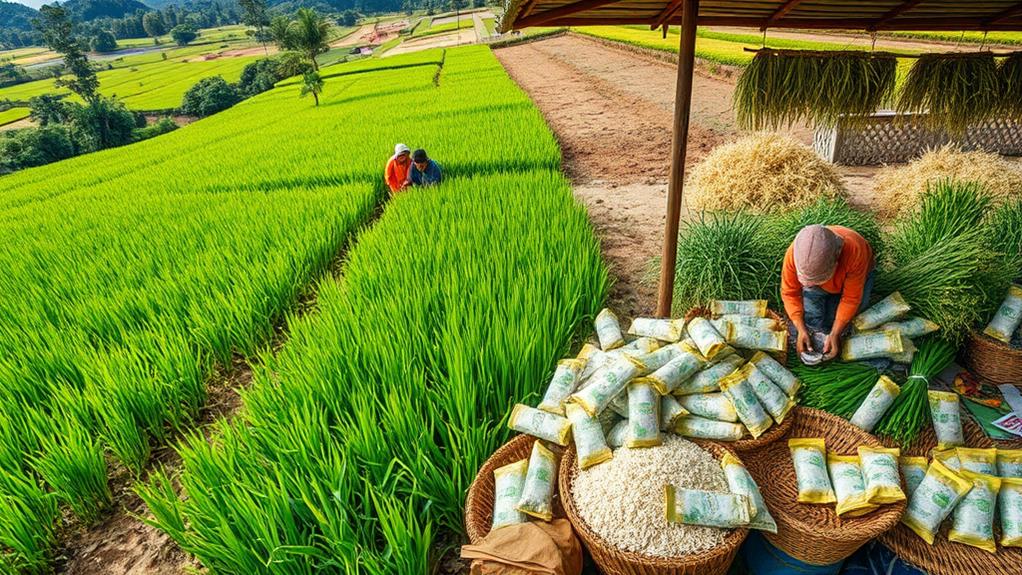
Climate change and environmental issues greatly affect rice production in the Philippines. High production costs make it hard for local farmers to compete with those in Vietnam and Thailand. For example, on-farm expenses in the Philippines exceed those in these neighboring countries, resulting in the Philippines relying heavily on rice imports, which take up about 7% of the national budget.
Even though the country has 3.4 million hectares of land suitable for rice, it's still the world's largest rice importer, showing a big gap between its potential and actual production.
Market price fluctuations also play a role in rice production. The average price of rice rose from P19.80 per kilogram in 2008 to P27.60 in 2022. This price instability discourages farmers from investing in their farms and planning for the future.
Additionally, there isn't enough investment in things like irrigation, fertilizers, and seeds, which has prevented productivity from growing. Since the late 1980s, rice production has remained stuck at around 19 million metric tons each year.
Small-scale farmers face challenges due to limited access to credit and modern technology, making it hard for them to buy necessary machinery.
These economic factors must be addressed to improve rice production and ensure food security in the Philippines.
Technological Innovations in Farming
Technological innovations in farming can greatly improve rice production in the Philippines. Hybrid rice varieties can increase yields, but many farmers still struggle to access these advanced seeds.
Precision agriculture tools, such as mobile apps, help farmers use resources more efficiently. These apps provide real-time market information and farming advice, which can lead to better decision-making and higher productivity.
Investments in irrigation improvements are important, especially during dry seasons, to manage water use effectively. Without proper irrigation systems, even the best seeds may not grow well.
Unfortunately, small-scale farmers often don't have access to these vital technologies, which limits their ability to improve their farming practices.
Training programs that focus on sustainable farming methods and modern techniques are essential. These programs help farmers learn the skills they need to adapt to new technologies.
By building agricultural resilience, these efforts can improve food security in the Philippines. In summary, adopting technological innovations in farming enhances farmer productivity and addresses challenges in the rice industry.
Ensuring access to these advancements is crucial for the future of rice production in the country.
Government Policies and Support
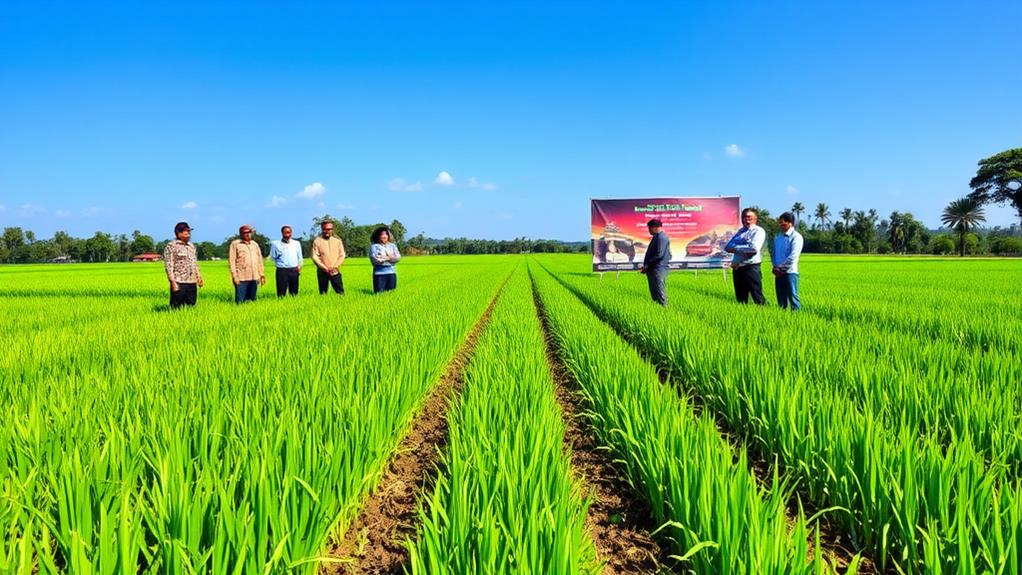
Access to modern technologies is only one part of improving rice production in the Philippines. Effective government policies and support are also crucial. The Philippine government has implemented important initiatives to enhance rice production.
The Rice Competitiveness Enhancement Fund (RCEF) allocates P10 billion in 2024 for mechanization, seed distribution, and training for farmers.
Policy changes by the Department of Agriculture aim to stabilize rice prices and improve food security. Smallholder farmers receive support through easier access to credit and necessary agricultural inputs, such as seeds and fertilizers.
Collaboration with NGOs and international organizations provides even more technical support and resources.
These government policies tackle the challenges that farmers face in increasing productivity and achieving economic stability.
By providing farmers with the right tools and resources, the government boosts rice production and enhances food security. The focus on policy-driven support is key to empowering farmers and promoting sustainable farming practices.
As these initiatives move forward, government support and farmer participation will shape the future of rice production in the Philippines.
Market Dynamics and Price Volatility
Rice prices in the Philippines have experienced significant ups and downs, affecting both consumers and farmers. The average price of rice increased from P19.80 per kilogram in 2008 to P27.60 per kilogram in 2022. This shows how much prices can change in a short time.
Supply and demand, along with trade policies, play a major role in these price changes. For instance, when India banned the export of non-basmati rice, prices in Southeast Asia went up by 22%. This highlights how countries rely on each other for rice.
To help stabilize rice prices, the government has set price ceilings. These limits help protect consumers from high prices while considering farmers' needs. However, inflation reached 4.1% in 2023, making food security a bigger issue. Rising rice prices affect how much families can spend on food.
The Philippines imports a lot of rice, with imports increasing from 1.7 million metric tons in 2003 to 2.2 million metric tons in 2004. This reliance on imports makes the country vulnerable to changes in the global market.
Understanding these market dynamics is essential for creating effective policies that ensure stable rice prices and food security for the population.
Climate Change Impacts
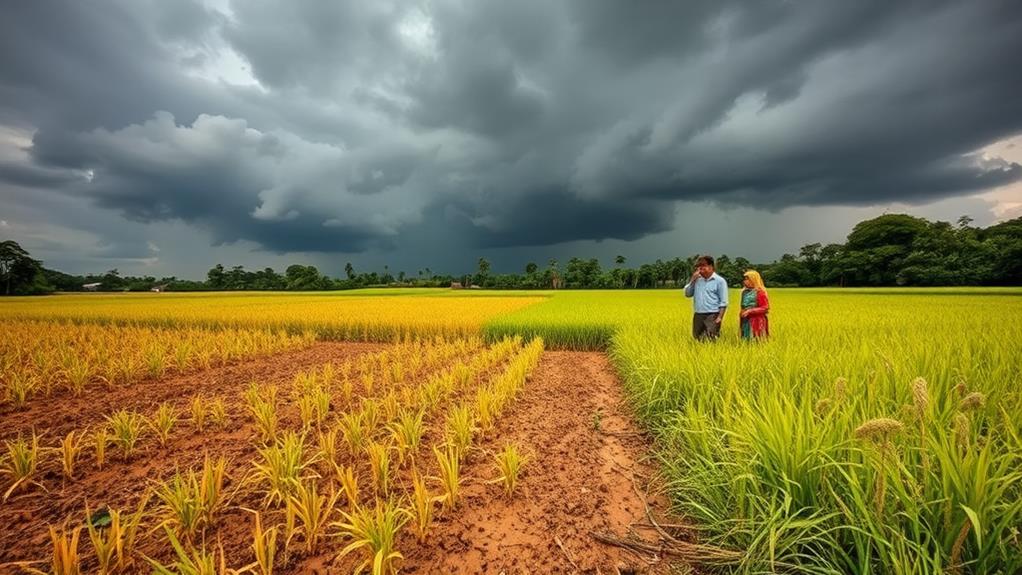
Climate change is having a significant impact on rice production in the Philippines. Yields are decreasing, and farmers' livelihoods are at risk. This decline is linked to extreme weather events like droughts and floods, which disrupt how much rice can be grown.
Soil quality is declining due to soil degradation, making it harder to farm effectively. Water scarcity is also a problem, as it limits irrigation and makes crops more vulnerable. Additionally, rising sea levels are causing flooding, which threatens farmland.
Pest outbreaks are more common because changing climates create favorable conditions for pests. These issues lead to a complex set of challenges for rice farming. As climate change continues, the chance of droughts and floods increases, which reduces both the quantity and quality of rice produced.
This not only threatens food security but also makes it harder for farmers to earn a living. To combat these challenges, it's essential for policymakers to support climate-resilient practices. Helping farmers adapt to ongoing changes is vital.
Without these measures, the future of rice production in the Philippines will remain uncertain, endangering food security for millions.
Strategies for Sustainable Practices
Given the challenges of climate change, adopting sustainable practices in rice production is crucial. Using integrated crop management (ICM) and the System for Rice Intensification (SRI) can greatly improve ecological efficiency. Many farmers stop using new techniques, which shows a need for a strong national plan to support these practices.
Investing in irrigation, fertilizers, and modern seed varieties is necessary to boost productivity in the Philippine rice sector, which has struggled since the late 1980s. Without these investments, it's hard to achieve better productivity and sustainability.
Working with research institutions is important because they can provide advice that meets the specific needs of small-scale farmers, especially those without access to modern technology.
Implementing climate-resilient agricultural practices is essential. These methods help reduce the negative impacts of climate change on rice production and improve food security in the area.
Regional Collaboration Efforts
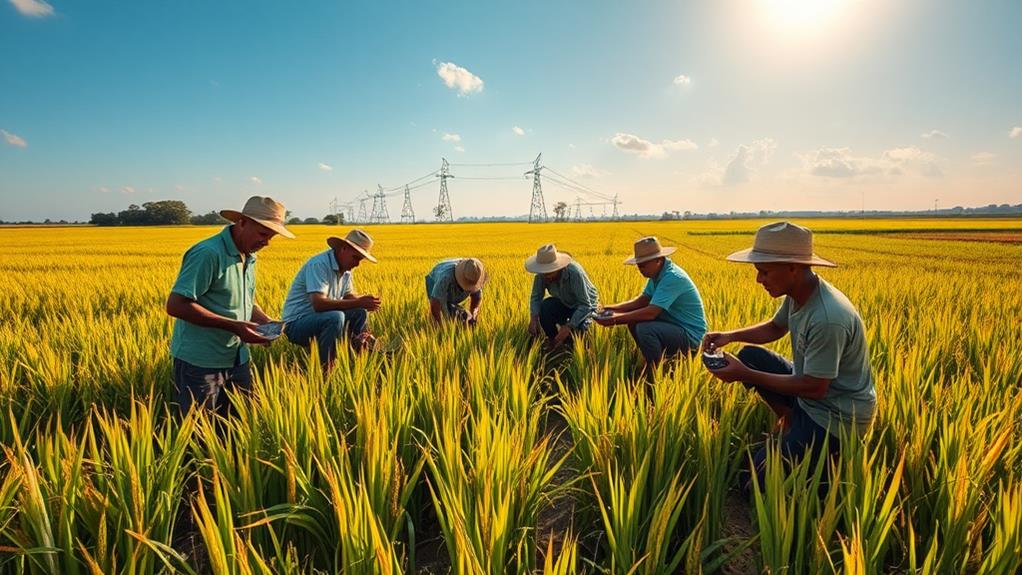
Regional collaboration among Southeast Asian countries is essential for improving rice production and ensuring food security. By working together, nations can share successful farming techniques and address issues that affect rice supply.
- Countries can exchange successful farming methods. For example, if one country has a technique that increases yield, others can adopt it to boost their own production.
- Joint efforts can help combat climate change. Research projects can be created to study how climate impacts rice farming, allowing countries to develop better strategies.
- The Asian Rice Platform is a proposed framework. This framework aims to improve cooperation in rice research, helping countries to innovate and find solutions together.
- Countries can create coordinated strategies. Each country can develop plans that specifically address its own challenges in rice production.
The ASEAN framework supports member countries in sharing best practices and improving farming policies. This cooperation not only increases rice output but also strengthens food security in the region.
By sharing technology, countries can also reduce the negative effects of climate change on rice production. Experts believe a unified approach is necessary.
By combining strengths, Southeast Asian nations can build a sustainable rice production system. This teamwork is vital for managing rising rice prices and supply issues.
How Does Rice Production in the Philippines Influence the Culinary Scene in Cagayan?
Rice production in the Philippines plays a vital role in shaping the culinary identity of Cagayan. From freshly harvested grains to traditional rice-based dishes, it adds authenticity to local flavors. Many musttry food stops in cagayan feature rice-centric meals, showcasing the region’s agricultural pride and celebrating its connection to Filipino heritage.
Future Prospects for Food Security
Food security in the Philippines relies on effective strategies to increase rice production and manage consumption. The country is the 8th largest rice producer in the world, but it only produces 19 million metric tons of rice each year. This amount isn't enough to meet local needs, leading to high imports. Climate change adds to this problem by causing extreme weather and soil degradation, which can reduce the amount of rice grown.
To improve rice production, the government needs to focus on better irrigation, sustainable farming practices, and support for small farmers. For example, providing farmers with access to water can help them grow more rice.
Additionally, using new technologies like hybrid rice varieties and precision agriculture can help farmers grow rice more efficiently and withstand environmental changes. These advancements are crucial for increasing rice yields.
Another important step is for the Philippines to work with other ASEAN nations to create rice trade agreements. This can help stabilize rice prices and ensure a steady supply of rice.
Questions and Answers
What Are the Challenges in Rice Production in the Philippines?
Rice production in the Philippines faces several challenges. One major issue is climate variability, which includes unpredictable weather patterns like droughts and floods that can reduce crop yields. For example, if a typhoon hits during the harvest season, it can destroy a significant portion of the rice crop.
Another challenge is inadequate pest management. Farmers often struggle to control pests that can damage rice plants. For instance, the rice leaffolder, a common pest, can cause serious harm to the crop if not managed properly.
Soil degradation is also a concern. Over time, soil can lose its nutrients, making it less fertile. This can lead to lower yields. For example, continuous planting without proper soil management practices can result in nutrient depletion.
Lastly, outdated irrigation systems can limit water supply to rice fields. Many farmers still rely on old methods that do not optimize water use. For instance, without efficient irrigation, crops may not receive enough water during dry spells, impacting their growth.
To overcome these challenges, it is important for farmers to adopt innovative strategies and sustainable agricultural practices. By addressing these issues, rice production in the Philippines can improve.
What Are the Challenges of Food Security in the Philippines?
Food security in the Philippines faces significant challenges. Climate change affects weather patterns, leading to more severe storms and droughts, which harm crop production. For example, heavy rains can flood rice fields, while prolonged dry spells can cause crops to wither.
Economic instability also plays a role. When the economy struggles, people have less money to spend on food. This can lead to higher prices and limited access to essential items. For instance, rising fuel costs can increase transportation expenses, making it harder for farmers to deliver their products to markets.
Additionally, inadequate agricultural practices hinder food production. Many farmers lack access to modern tools and techniques, resulting in lower yields. For example, without proper irrigation systems, crops may not receive enough water, affecting their growth and harvest.
Population growth complicates these issues further. As more people are born, the demand for food increases. This puts pressure on existing food sources and can lead to shortages.
How Does Rice Contribute to Food Security?
Rice plays a crucial role in food security by affecting how people eat. It is important to promote sustainable farming practices to ensure that rice can be grown without harming the environment. For example, using less water and avoiding harmful pesticides can help keep rice production steady. Effective government policies are also needed to maintain stable production levels. This means creating rules that support farmers and protect them from sudden changes in the market. For instance, setting prices for rice can help farmers earn a living and provide food for communities. By focusing on these practices, we can reduce risks from global market changes and improve nutrition. Eating rice is part of many diets, and ensuring its availability helps everyone get the food they need.
What Challenges or Issues Were Related to Rice Production?
Rice production faces several significant challenges. Climate change affects weather patterns, leading to unpredictable rainfall and temperature extremes that can damage crops. For example, floods and droughts can reduce yields significantly.
Another issue is ineffective pest management. Farmers often struggle with pests that can destroy rice plants. Without proper tools or knowledge to combat these pests, crop losses can be severe.
Additionally, there are inadequate irrigation systems. In many regions, farmers do not have access to reliable water sources. This can lead to water shortages during critical growth periods, impacting the overall harvest.
Lastly, limited market access prevents farmers from selling their rice at fair prices. In some areas, farmers cannot reach markets due to poor infrastructure, which reduces their income and ability to invest in better farming practices.
These challenges threaten both rice production and food stability for communities that depend on rice as a staple food.